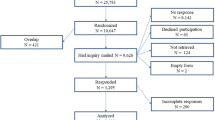Abstract
Non-tenure track faculty members (NTTF) constitute what has been referred to by scholars as the new faculty majority. The growing numbers of NTTF have led to debates about the role they should play in shared governance. Currently, however, an overall lack of empirical knowledge exists regarding the status of their involvement in institutional governance. Using data from highest research activity doctoral universities, this study investigated current standards related to NTTF eligibility for election to institution-wide faculty senates. We also explored what these faculty governance standards and criteria reveal about the status and position of NTTF within the professoriate.
Similar content being viewed by others
References
American Association of University Professors (2013). The inclusion in governance of faculty members holding contingent appointments. Washington, DC. Retrieved from http://www.aaup.org/report/governance-inclusion
Association of Governing Boards of Universities and Colleges (2016). Shared governance: Is ok good enough? Retrieved from https://www.agb.org/reports/2016/shared-governance-is-ok-good-enough
Baldwin, R. G., & Chronister, J. L. (2001). Teaching without tenure: Policies and practices for a new era. Baltimore, MD: Johns Hopkins University Press.
Berry, J. (2005). Reclaiming the ivory tower: Organizing adjuncts to change higher education. New York, NY: Monthly Review Press.
Birnbaum, R. (1989). The latent organizational functions of the academic senate: Why senates do not work but will not go away. The Journal of Higher Education, 60, 423–443. doi:10.2307/1982064. Retrieved from http://www.jstor.org.ezproxy.uky.edu/stable/1982064
Birnbaum, R. (1991). How colleges work: The cybernetics of academic organization and leadership. San Francisco, CA: Jossey-Bass.
Bland, C. J., Center, B. A., Finstad, D. A., Risbey, K. R., & Staples, J. (2006). The impact of appointment type on the productivity and commitment of full-time faculty in research and doctoral institutions. The Journal of Higher Education, 77, 89–123. doi:10.1353/jhe.2006.0002
Center for the Education of Women (2007). Making the best of both worlds: Findings from a national institution-level survey on non-tenure track faculty. Ann Arbor, MI: Center for the Education of Women. Retrieved from http://www.cew.umich.edu/research/pubs/hepubs/contingent
Cross, J. G., & Goldenberg, E. N. (2009). Off-track profs: Nontenured teachers in higher education. Cambridge, MA: MIT Press.
Curtis, J. W., & Thornton, S. (2013). The annual report on the economic status of the profession, 2012–2013. Washington, DC: American Association of University Professors. Retrieved from http://www.aaup.org/report/heres-news-annual-report-economic-status-profession-2012-13
Ehrenberg, R. G., & Zhang, L. (2005). Do tenured and tenure-track faculty matter? Journal of Human Resources 40, 647–659. doi:10.3368/jhr.XL.3.647
Figlio, D. N., Schapiro, M. O., & Soter, K. B. (2015). Are tenure track professors better teachers? Review of Economics and Statistics, 97, 715–724. doi:10.1162/REST_a_00529
Flaherty, C. (2015, Febuary 17). More than adjuncts. Inside Higher Ed. Retrieved from https://www.insidehighered.com/news/2015/02/17/new-faculty-model-u-denver-could-be-prototype-reform
Gappa, J. M., & Leslie, D. W. (1993). The invisible faculty: Improving the status of part-timers in higher education. San Francisco, CA: Jossey-Bass.
Hutchens, N. H. (2011). Using a legal lens to better understand and frame issues shaping the employment environment of non-tenure track faculty members. American Behavioral Scientist, 1443–1460. doi:10.1177/0002764211409192
Jencks, C., & Riesman, D. (1968). The academic revolution. New Brunswick, NJ: Transaction Publishers.
Kezar, A. (2013). Departmental cultures and non-tenure-track faculty: Willingness, capacity, and opportunity to perform at four-year institutions. The Journal of Higher Education, 84, 153–188. doi:10.1353/jhe.2013.0011
Kezar, A. (Ed.). (2012). Embracing non-tenure track faculty: Changing campuses for the new faculty majority. New York, NY: Routledge.
Kezar, A., Lester, J., & Anderson, G. (2006). Challenging stereotypes that interfere with effective governance. Thought and Action, Fall, 2016, 121–134. Retrieved from http://www.nea.org/home/1821.htm
Kezar, A., & Sam, C. (2010a). Beyond contracts: Non-tenure track faculty and campus governance. The NEA Almanac of Higher Education. Washington, DC: National Education Association.
Kezar, A., & Sam, C. (2010b). Non-tenure-track faculty in higher education: Theories and tensions. Hoboken, NJ: Jossey-Bass.
Kezar, A., & Sam, C. (2010c). Understanding the new majority of non-tenure-track faculty in higher education: Demographics, experiences, and plans of action. San Francisco, CA: Jossey-Bass.
Kezar, A., & Sam, C. (2014). Governance as a catalyst for policy change creating a contingent faculty friendly academy. Educational Policy, 28, 425–462. doi:10.1177/0895904812465112
Kuntz, A. M. (2012). Reconsidering the workplace: Faculty perceptions of their work and working environments. Studies in Higher Education, 37, 769–782. doi:10.1080/03075079.2010.541556
Morrison, J. D. (2008). Faculty governance and nontenure-track appointments. New Directions for Higher Education, 143, 21–27. doi:10.1002/he.309
Powell, W., & DiMaggio, P. (Eds.). (1991). The new institutionalism in organizational analysis. Chicago, IL: University of Chicago Press.
Reybold, L. E. (2003). Pathways to the professorate: The development of faculty identity in education. Innovative Higher Education, 235–252. doi:10.1023/A:1024024430041
Rhoades, G., & Maitland, C. (2008). Bargaining for full-time, non-tenure track faculty: Best practices. Washington, DC: National Educaton Association.
Schuster, J. H., & Finkelstein, M. J. (2006). The American faculty: The restructuring of academic work and careers. Baltimore, MD: John Hopkins University Press.
Task Force on Non-Tenure-Track Faculty (2013). Non-tenure-track faculty in U.S. Universities: AERA statement and background report. Washington, DC. Retrieved from http://www.aera.net/Portals/38/docs/Education_Research_and_Research_Policy/NonTenTrackFaculty_R4.pdf
Tierney, W. G., & Bensimon, E. M. (1996). Promotion and tenure: Community and socialization in academe. Albany, NY: State University of New York Press.
Tierney, W. G., & Rhoads, R. A. (1994). Faculty socialization as cultural process: A mirror of institutional commitment. San Francisco, CA: Jossey-Bass.
Umbach, P. D. (2007). How effective are they? Exploring the impact of contingent faculty on undergraduate education. The Review of Higher Education, 30, 91–123. doi:10.1353/rhe.2006.0080
Wilson, R. (2013, March 18). The new faculty minority. The Chronicle of Higher Education. Retrieved from http://chronicle.com/article/The-New-Faculty-Minority/137945/
Author information
Authors and Affiliations
Corresponding author
Rights and permissions
About this article
Cite this article
Jones, W.A., Hutchens, N.H., Hulbert, A. et al. Shared Governance among the new Majority: Non-Tenure Track Faculty Eligibility for Election to University Faculty Senates. Innov High Educ 42, 505–519 (2017). https://doi.org/10.1007/s10755-017-9402-2
Published:
Issue Date:
DOI: https://doi.org/10.1007/s10755-017-9402-2




